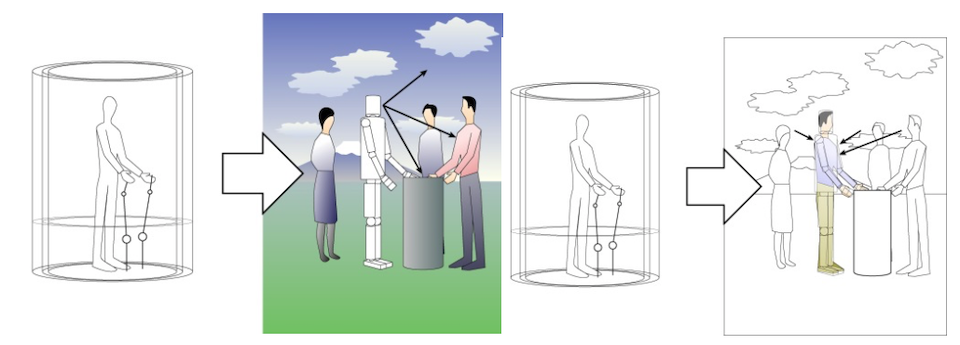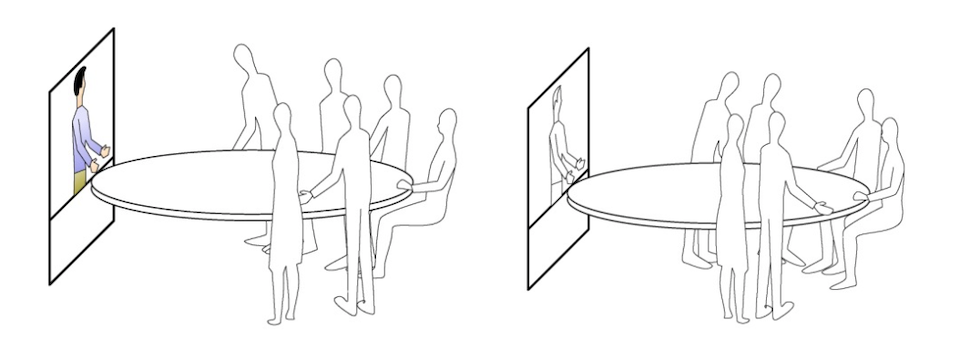What are the sense of self-existence and the sense of their existence. | How the sense of their existence occurs.
What are the sense of self-existence and the sense of their existence.
The feeling of actually having put oneself in a certain place is referred to as the “sense of self-existence,” or “sense of self-presence”. This is the “sense of realism.” The audio stereo system that creates a listening effect similar to being in a concert hall might be referred to as a system filled with realism. This is auditory realism. Virtual reality and telexistence provide the user of the system with a realistic sensation of having visited the environment generated by the computer and/or an actual remote environment. In realism, the senses of vision, hearing, touch, smell, taste, and body balance are all ideally aligned, and studies are being conducted to facilitate ultimate realism in virtual reality and telexistence.
Thus, realism is a word frequently used to describe the capabilities of sound reproduction equipment such as the stereo or the telephone, and visual reproduction technology such as film, television, and the video phone. In these cases, realism denotes the sensation felt by the user of the system.
There is also a sensation referred to as the “sense of their existence” or the “sense of their presence.” The sense of their existence is the feeling of the definite existence of people or objects. This term was in use before the invention of telephones, stereos, or movies. There are innumerable examples of phrases such as “he has no sense of existence or presence” used in the real world. Specifically, in spite of a person being present as an entity, the people around the person may not notice their presence and there may be occasions when their presence is ignored. In contrast, when the person is more than a mere physical entity and their existence is noticeable, they are said to have a strong presence, or that they are “larger than life.”
The “sense of self-existence”, i.e., the feeling of being present in the place felt by the user and the “sense of their existence”, i.e., the presence of the user felt by the people nearby are illustrated in Fig.3.

Fig. 3. Sense of self-existence: The user of the system has the feeling of being present in the place (left),
and Sense of his existence: The people nearby feel the presence of the user of the system (right).
What are the sense of self-existence and the sense of their existence. | How the sense of their existence occurs.
How the sense of their existence occurs.
With the spread of video conferencing, the lack of the sense of the presence of a person on the screen was perceived as a shortcoming, as much as in the real world. The lack of the sense of presence is considered natural, given the absence of a physical entity. However, the reasons why a sense of presence cannot be created using only pictures and sounds remain unsolved. Researchers are attempting to integrate a sense of self-presence and sense of their presence, currently missing in typical teleconference systems, into virtual reality and telexistence systems, and to achieve the ultimate sense of presence, along with a sense of realism.
The sense of self-presence and sense of his presence are described below, utilizing the video conferencing system as an example. As displayed in the figure, there is a large screen in the conference room and one person is participating in the conference from a distant place. The person participating from the distant place sees the image of the camera installed in the conference room on the monitor placed in his room. Because the present system is usually two-dimensional, the sense of self-presence is obtained to some extent and is not exactly like being there. This is what is felt by the user of the system from the distant place.
At the other location, the people gathered in the meeting room look at the screen and welcome the participant from the distant place, and at that time, everybody notices him. A certain kind of a sense of his presence is created at that time. However, the person on the screen may be forgotten when the discussion among the people who have actually gathered in the conference room gets heated. In this situation, the sense of his presence becomes very weak (Fig.4).

Fig. 4. He is noticed at first. He is forgotten soon.
To summarize, the sense of self-presence or self-existence is what is felt by the user of the system, and is a feeling of being present in the generated or remote environment. In contrast, the sense of their presence or sense of their existence is not what the user of the system feels, but what the people around the user of the system feel regarding the user’s presence.
In that case, what is it that conveys a sense of presence or sense of existence? If the sense of presence in the real world is analyzed as an example, a higher possibility of having an impact on the people who are nearby will generally result in a higher sense of their existence. The sense of presence is as high as the degree or effectiveness of the potential for interaction. Between a stone that is stable on the floor and one that may tumble down at any moment, the latter has a higher sense of presence. If a wasp, a poisonous snake, or a lion is in one’s immediate vicinity, its sense of presence is high. Likewise, things that make a loud noise, are colorful, or move about have a high sense of presence. People who are quiet and yet convey a sense of presence also have a dignity and an aura about them. When all the people in an environment feel, for some reason, a sense of danger, fear, or enjoyment because of the existence of an object or a person, an interaction takes place and the possibility of being affected heightens the sense of their presence.
The reason why the sense of presence is greater in a live performance or in a play than in television or in films originates from the feeling that it is possible to touch the viewer at any moment. The difference in the sense of presence between watching a game of sumo wrestling from the gallery where a giant sumo wrestler can come falling down and watching it on a big screen TV is quite evident.
In order to create the sense of their existence in media, it is obviously important to convey what is not present in the existing images, such as a complete three-dimensional feeling with multi-view support, the sense of smell, and other stimuli. In addition, it is necessary to provide a structure to enable the possibility of direct interaction with the generated object or person, and in particular, one that can detect danger.
In this context, among the insufficient sensations, the sense of touch is, at present, more likely to contribute to the creation of the sense of presence. However, the sense of presence can be conveyed even if contact does not actually occur. In other words, there is a high sense of presence of something frightening that may cause harm.